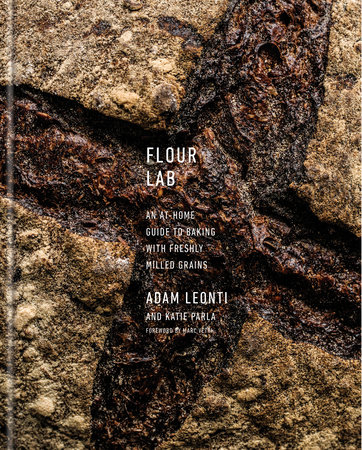Flour Lab
An At-Home Guide to Baking with Freshly Milled Grains
Adam Leonti with Katie Parla, Foreword by Marc Vetri
Ebook
September 10, 2019 | ISBN 9781524760977
AmazonApple BooksBarnes & NobleBooks A MillionGoogle Play StoreKobo
About the Book
The most accessible and authoritative guide to making delicious homemade bread using flour milled from whole grains—with dozens of recipes!
“Bread lovers of all skill levels are sure to find themselves returning to this one time and again.”—Publishers Weekly (starred review)
A pioneer of the at-home milling movement, Adam Leonti has written the definitive guide that modernizes this old-world tradition for home cooks and amateur breadheads. With step-by-step photographs and comprehensive instructions to guide you through each technique, plus guidance on all aspects of home milling, including sourcing wheat or flour and choosing the right equipment for your kitchen, Flour Lab is a master class at making better-tasting and more nutritious food.
Thirty-five recipes for bread, pasta, pizza, cake, and pastry serve as a practical base, and Leonti provides dozens of delicious recipes to tailor them to your taste, including:
• Bread: Potato Rolls with Honey Butter; Bagels; Yeasted Ciabatta
• Pasta: Canderli (bread dumplings); Ricotta and Lemon Zest Ravioli; Chicken Liver and Saffron Ragù
• Pizza: Butter, Honey, and Lavender Bianco-style Pizza; Robia, Mortadella, and Arugula Pizza al Taglio; Tomato and Stracciatella Pizza Napoletana
• Pastry, Cookies, and Cakes: Biscotti with almond and grapefruit; Whole Wheat Croissants; Carrot Cake with Cream Cheese Frosting
Embracing freshly milled flour in these recipes—and all the ones you already love to make—will ensure that you never have a stale meal again.
Praise for Flour Lab
“Do you want to make pasta from freshly milled our? Pizza and focaccia? Pastry and bread? The genius of this book is that it expands the possibilities of using freshly milled grains—think flavor, texture, nutrition, uniqueness—across a broad, delicious spectrum. Adam Leonti’s Flour Lab is clearly composed, enthusiastic, and inspiring.”—Ken Forkish, author of Flour Water Salt Yeast
“Flour Lab is not only a beautiful and inspiring book, but it also vividly portrays, through its excellently written narrative and amazing recipes, the personal—yet universal—journey of the artisan soul. Adam Leonti’s own discovery process of the joys of milling and baking with fresh flour is now a lasting and enriching gift to us all.”—Peter Reinhart, author of The Bread Baker’s Apprentice, Bread Revolution, and Perfect Pan Pizza
“Bread lovers of all skill levels are sure to find themselves returning to this one time and again.”—Publishers Weekly (starred review)
A pioneer of the at-home milling movement, Adam Leonti has written the definitive guide that modernizes this old-world tradition for home cooks and amateur breadheads. With step-by-step photographs and comprehensive instructions to guide you through each technique, plus guidance on all aspects of home milling, including sourcing wheat or flour and choosing the right equipment for your kitchen, Flour Lab is a master class at making better-tasting and more nutritious food.
Thirty-five recipes for bread, pasta, pizza, cake, and pastry serve as a practical base, and Leonti provides dozens of delicious recipes to tailor them to your taste, including:
• Bread: Potato Rolls with Honey Butter; Bagels; Yeasted Ciabatta
• Pasta: Canderli (bread dumplings); Ricotta and Lemon Zest Ravioli; Chicken Liver and Saffron Ragù
• Pizza: Butter, Honey, and Lavender Bianco-style Pizza; Robia, Mortadella, and Arugula Pizza al Taglio; Tomato and Stracciatella Pizza Napoletana
• Pastry, Cookies, and Cakes: Biscotti with almond and grapefruit; Whole Wheat Croissants; Carrot Cake with Cream Cheese Frosting
Embracing freshly milled flour in these recipes—and all the ones you already love to make—will ensure that you never have a stale meal again.
Praise for Flour Lab
“Do you want to make pasta from freshly milled our? Pizza and focaccia? Pastry and bread? The genius of this book is that it expands the possibilities of using freshly milled grains—think flavor, texture, nutrition, uniqueness—across a broad, delicious spectrum. Adam Leonti’s Flour Lab is clearly composed, enthusiastic, and inspiring.”—Ken Forkish, author of Flour Water Salt Yeast
“Flour Lab is not only a beautiful and inspiring book, but it also vividly portrays, through its excellently written narrative and amazing recipes, the personal—yet universal—journey of the artisan soul. Adam Leonti’s own discovery process of the joys of milling and baking with fresh flour is now a lasting and enriching gift to us all.”—Peter Reinhart, author of The Bread Baker’s Apprentice, Bread Revolution, and Perfect Pan Pizza
Read more
Close




